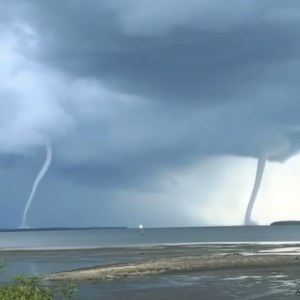Two intense marine storms hit the coastal region near [location] within minutes of each other, unleashing destructive winds, torrential rainfall, and dangerously high waves that have paralyzed maritime activity. What began as a routine weather disturbance escalated into a full-scale marine emergency, leaving authorities scrambling to protect lives and minimize damage.
Meteorological agencies confirmed that the twin storms developed rapidly over open waters before moving inland, catching many vessels and fishing operations off guard. Wind speeds exceeded 100 kilometers per hour in some areas, while waves surged to over six meters, hammering piers, marinas, and coastal infrastructure. Local officials immediately activated emergency protocols, issuing red-level warnings to all maritime operators and residents along the coast.
“Conditions are extremely hazardous. We’re urging everyone — fishermen, boaters, and beachgoers — to stay off the water and away from shorelines until further notice,” said Captain Arun Dev of the regional maritime authority. “This is not a normal storm; it’s a double system feeding on itself, creating unpredictable wave and wind patterns.”
By early afternoon, the impact was already severe. Fishing boats that had left harbor in the morning rushed to return but struggled against the chaotic waves. Port authorities suspended all sea traffic and ordered immediate closures at commercial docks. Several small vessels have been reported stranded or damaged, and emergency teams are monitoring distress signals across the area.
Although no fatalities have been reported, rescue operations are ongoing. Coast Guard units and local disaster-response agencies have deployed patrol boats and helicopters to monitor stranded vessels and assist with potential evacuations. “We’re in full emergency mode,” said Lieutenant Marina Lopez of the Coastal Response Unit. “Our priority is keeping people alive. The property can be rebuilt later.”
The storms have also triggered inland consequences. Heavy rainfall has led to flash flooding in low-lying communities, overwhelming drainage systems and submerging roads. Local authorities have set up temporary shelters for displaced residents, while public transportation in coastal zones has been suspended until conditions improve.
Meteorologists warn that the storms could strengthen overnight. Satellite models suggest the systems may merge into a single larger storm front, raising concerns about further flooding, mudslides, and coastal erosion. “The danger isn’t over,” said Dr. Nikhil Varma from the National Weather Center. “The combined pressure zones could bring more rainfall in the next 12 to 18 hours. Residents should remain indoors and be prepared for possible power outages.”
Residents across the region have been advised to secure outdoor belongings, unplug electrical devices, and keep emergency kits ready. Supermarkets and gas stations saw long lines throughout the day as families stocked up on water, nonperishables, and fuel. “People remember the last big storm,” said local shopkeeper Meena Rao. “Nobody wants to be caught unprepared again.”
Emergency hotlines are receiving hundreds of calls, mostly from people seeking updates on missing fishermen or requesting evacuation assistance. The national disaster management agency has set up a real-time online dashboard to track weather updates, flood zones, and shelter availability.
Meanwhile, infrastructure damage is already visible. Several fishing docks have been torn apart, and beachside roads are littered with debris. Power lines have collapsed in multiple areas, cutting electricity to thousands of homes. Repair crews have been instructed to wait until winds subside before attempting restorations.
Despite the chaos, local communities have mobilized quickly. Volunteer groups and coast guards are distributing supplies to elderly residents and assisting with evacuations. Churches, schools, and community centers have opened their doors as temporary shelters, offering food, blankets, and medical care. “The spirit of this community is strong,” said Mayor Rina Patel. “Even in the middle of disaster, people are looking out for each other.”
Officials continue to stress that the situation remains volatile. The combination of unstable ocean currents and saturated soil means that even after the immediate storm passes, residual flooding and landslides could occur. Meteorologists have cautioned that the recovery phase will likely take several weeks.
As night falls over the storm-battered coast, the sound of wind and waves still dominates the air. Emergency sirens echo in the distance, and rescue lights sweep across dark waters. For now, the coastline holds its breath — waiting for the storms to pass, for the winds to calm, and for the long process of recovery to begin.
Authorities urge residents to remain patient, vigilant, and connected to official updates. “We can rebuild the docks, the boats, and the roads,” Captain Dev said. “But we can’t replace lives. Stay safe, stay home, and don’t take risks until the sea gives us back our calm.”



